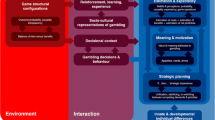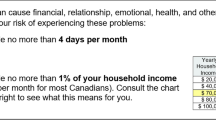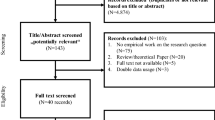Abstract
Perception of the consequences of risk affects motivation and behaviour. In gambling, distorted expectations and preferences towards outcomes are associated with significant social and clinical harms. A systematic review was conducted to examine the relationship between gambling risk perception and behaviour. Sixteen studies met inclusion criteria. Studies provided evidence that disordered gamblers hold both more optimistic overall perceptions of risk, and a mixture of more positive and more negative specific outcome expectations. Preliminary evidence suggests a range of contextual and individual differences moderate risk perception affecting decision-making. Disordered gamblers appear to sustain motivation to gamble, despite more negative expectations and experiences, via cognitive processes that result in preferential emphasis on positive over negative outcomes. Given potential differences in the perception of risk between various categories of gamblers, clinicians should take into account how gamblers in treatment view gambling as a risky behaviour. Improving the accuracy of such perceptions may reduce the propensity for risk-taking behaviours.
Similar content being viewed by others
References
Aarons, G. A., Brown, S. A., Stice, E., & Coe, M. T. (2001). Psychometric evaluation of the Marijuana and Stimulant Effect Expectancy Questionnaires for adolescents. Addictive Behaviors, 26(2), 219–236.
Ainslie, G. (1975). Specious reward: A behavioral theory of impulsiveness and impulse control. Psychological Bulletin, 82(4), 463–496.
Ajzen, I. (2011). The theory of planned behaviour: Reactions and reflections. Psychology and Health, 26(9), 1113–1127.
Albarracin, D., Johnson, B. T., Fishbein, M., & Muellerleile, P. A. (2001). Theories of reasoned action and planned behavior as models of condom use: A meta-analysis. Psychological Bulletin, 127(1), 142–161.
Anderson, A., Sisask, M., & Varnik, A. (2011). Familicide and suicide in a case of gambling dependence. Journal of Forensic Psychiatry and Psychology, 22(1), 156–168.
Auslander, B. A. (1999). An exploratory study investigating variables in relation to juvenile sexual reoffending. Auslander: The Florida State University.
Baron, R. M., & Kenny, D. A. (1986). The moderator-mediator variable distinction in social psychological research: Conceptual, strategic, and statistical considerations. Journal of Personality and Social Psychology, 51(6), 1173–1182.
Baudinet, J., & Blaszczynski, A. (2012). Arousal and gambling mode preference: A review of the literature. Journal of Gambling Studies, 8(8). doi:10.1007/s10899-012-9304-2.
Binde, P. (2009). Gambling motivation and involvement: a review of social science research. Ostersund: Swedish National Institute of Public Health.
Blaszczynski, A., & Nower, L. (2002). A pathways model of problem and pathological gambling. Addiction, 97(5), 487–499.
Breakwell, G. M. (2007). The psychology of risk. New York: Cambridge University Press.
Campbell, S. (2006). Risk and the subjectivity of preference. Journal of Risk Research, 9(3), 225–242.
Clarke, D., Tse, S., Abbott, M. W., Townsend, S., Kingi, P., & Manaia, W. (2007). Reasons for starting and continuing gambling in a mixed ethnic community sample of pathological and non-problem gamblers. International Gambling Studies, 7(3), 299–313.
Cooper, J. (2012). Handbook of theories of social psychology (Vol 1). Thousand Oaks: Sage Publications Ltd.
Cotte, J. (1997). Chances, trances and lots of slots: Gambling motives and consumption experiences. Journal of Leisure Research, 29(4), 380–406.
Crockford, D. N., & el-Guebaly, N. (1998). Psychiatric comorbidity in pathological gambling: A critical review. The Canadian Journal of Psychiatry, 43(1), 43–50.
Dean, D. H. (2011). A path model of perceived financial risk in casino blackjack. Young Consumers, 12(1), 15–26.
Delfabbro, P. (2004). The stubborn logic of regular gamblers: Obstacles and dilemmas in cognitive gambling research. Journal of Gambling Studies, 20(1), 1–21.
Delfabbro, P., & Thrupp, L. (2003). The social determinants of youth gambling in South Australian adolescents. Journal of Adolescence, 26(3), 313–330.
Delfabbro, P., Lahn, J., & Grabosky, P. (2006). It’s not what you know, but how you use it: Statistical knowledge and adolescent problem gambling. Journal of Gambling Studies, 22(2), 179–193.
Delfabbro, P., Lambos, C., King, D., & Puglies, S. (2009). Knowledge and beliefs about gambling in Australian secondary school students and their implications for education strategies. Journal of Gambling Studies, 25(4), 523–539.
Derevensky, J., Sklar, A., Gupta, R., & Messerlian, C. (2010). An empirical study examining the impact of gambling advertisements on adolescent gambling attitudes and behaviors. International Journal of Mental Health and Addiction, 8(1), 21–34.
Dhillon, J., Horch, J. D., & Hodgins, D. C. (2011). Cultural influences on stigmatization of problem gambling: East Asian and Caucasian Canadians. Journal of Gambling Studies, 27(4), 633–647.
Fisher, S. (2000). Developing the DSM IV criteria to identify adolescent problem gambling in non-clinical populations. Journal of Gambling Studies, 16(2), 253–273.
Floyd, F. J., & Widaman, K. F. (1995). Factor analysis in the development and refinement of clinical assessment instruments. Psychological Assessment, 7(3), 286–299.
Fortune, E. E., & Goodie, A. S. (2011). Cognitive distortions as a component and treatment focus of pathological gambling: A review. Psychology of Addictive Behaviors, 26(2), 298–310.
Freidenberg, B. M., Blanchard, E. B., Wulfert, E., & Malta, L. S. (2002). Changes in physiological arousal to gambling cues among participants in motivationally enhanced cognitive-behavior therapy for pathological gambling: A preliminary study. Applied psychophysiology and biofeedback, 27(4), 251–260.
Gawin, F. (1991). Cocaine addiction: Psychology and neurophysiology. Science, 251(5001), 1580–1586.
Gillespie, M. A., Derevensky, J., & Gupta, R. (2007a). I. Adolescent problem gambling: Developing a gambling expectancy instrument. Journal of Gambling Issues, 19, 51–68.
Gillespie, M. A., Derevensky, J., & Gupta, R. (2007b). II. The utility of outcome expectancies in the prediction of adolescent gambling behaviour. Journal of Gambling Issues, 19, 69–86.
Gilovich, T. (1983). Biased evaluation and persistence in gambling. Journal of Personality and Social Psychology, 44(6), 1110–1126.
Glanz, K., Rimer, B. K., & Viswanath, K. (2008). Health behavior and health education: Theory, research, and practice (4th ed.). San Francisco: Jossey-Bass.
Goldberg, J., & Fischhoff, B. (2000). The long-term risks in the short-term benefits: Perceptions of potentially addictive activities. Health Psychology, 19(3), 299–303.
Goldberg, J., Halpern-Felsher, B., & Millstein, S. (2002). Beyond invulnerability: The importance of benefits in adolescents’ decision to drink alcohol. Health Psychology, 21(5), 477–484.
Goldstein, R. Z., Craig, A., Bechara, A., Garavan, H., Childress, A. R., Paulus, M. P., et al. (2009). The neurocircuitry of impaired insight in drug addiction. Trends in Cognitive Sciences, 13(9), 372–380.
Goudriaan, A. E., Oosterlaan, J., de Beurs, E., & Van den Brink, W. (2004). Pathological gambling: A comprehensive review of biobehavioral findings. Neuroscience and Biobehavioral Reviews, 28(2), 123–141.
Grant, J. E., Brewer, J. A., & Potenza, M. N. (2006). The neurobiology of substance and behavioral addictions. CNS Spectrums, 11(12), 924–930.
Hall, H. V., & Poirier, J. G. (2001). Detecting malingering and deception: Forensic distortion analysis (2nd ed.). Boca Raton: CRC Press; US.
Hing, N., & Breen, H. (2008). Risk and protective factors relating to gambling by employees of gaming venues. International Gambling Studies, 8(1), 1–23.
Hing, N., Breen, H., & Gordon, A. (2012). A case study of gambling involvement and its consequences. Leisure Sciences, 34(3), 217–235.
Howard, M., McMillen, C., Nower, L., Elze, D., Edmond, T., & Bricout, J. (2002). Denial in addiction: Towards an integrated stage and process model–Qualitative findings. Journal of Psychoactive Drugs, 34(4), 371–382.
Inglin, S., & Gmel, G. (2011). Beliefs about and attitudes toward gambling in French-speaking Switzerland. Journal of Gambling Studies, 27(2), 299–316.
Jacobsen, L. H., Knudsen, A. K., Krogh, E., Pallesen, S., & Molde, H. (2007). An overview of cognitive mechanisms in pathological gambling. Nordic Psychology, 59(4), 347–361.
James, W. H., Lonczak, H. S., & Moore, D. D. (1996). The role of denial and defensiveness in drug use among adolescents. Journal of Child and Adolescent Substance Abuse, 5(2), 17–42.
Jarcho, J. M., Berkman, E. T., & Lieberman, M. D. (2011). The neural basis of rationalization: Cognitive dissonance reduction during decision-making. Social Cognitive and Affective Neuroscience, 6(4), 460–467.
Jessor, R. (1998). New perspectives on adolescent risk behavior. New York: Cambridge University Press.
Johansson, A., Grant, J. E., Kim, S. W., Odlaug, B. L., & Gotestam, K. (2009). Risk factors for problematic gambling: A critical literature review. Journal of Gambling Studies, 25(1), 67–92.
Jones, B. T., Corbin, W., & Fromme, K. (2001). A review of expectancy theory and alcohol consumption. Addiction, 96(1), 57–72.
Joukhador, J., Blaszczynski, A., & Maccallum, F. (2004). Superstitious beliefs in gambling among problem and non-problem gamblers: Preliminary data. Journal of Gambling Studies, 20(2), 171–180.
Kim, W. (2012). Acculturation and gambling in Asian Americans: When culture meets availability. International Gambling Studies, 12(1), 69–88.
Kuentzel, J. G., Henderson, M. J., & Melville, C. L. (2008). The impact of social desirability biases on self-report among college student and problem gamblers. Journal of Gambling Studies, 24(3), 307–319.
Lambos, C., & Delfabbro, P. (2007). Numerical reasoning ability and irrational beliefs in problem gambling. International Gambling Studies, 7(2), 157–171.
Lee, H. P., Chae, P. K., Lee, H. S., & Kim, Y. K. (2007). The five-factor gambling motivation model. Psychiatry Research, 150(1), 21–32.
Leigh, B. C. (1999). Peril, chance, adventure: Concepts of risk, alcohol use and risky behavior in young adults. Addiction, 94(3), 371–383.
Lesieur, H. R., & Blume, S. B. (1987). The South Oaks Gambling Screen: a new instrument for the identification of pathological gamblers. American Journal of Psychiatry, 144(9), 1184–1188.
Li, S., Zhou, K., Sun, Y., Rao, L. L., Zheng, R., & Liang, Z. Y. (2010). Anticipated regret, risk perception, or both: Which is most likely responsible for our intention to gamble? Journal of Gambling Studies, 26(1), 105–116.
Lipkus, I. M., Eissenberg, T., Schwartz-Bloom, R. D., Prokhorov, A. V., & Levy, J. (2011). Affecting perceptions of harm and addiction among college waterpipe tobacco smokers. Nicotine and Tobacco Research, 13(7), 599–610.
Luengo, A. F. A., Encinas, F. J. L., Herranz, G. R., Gonzalez, B. R., Sastron, O. F., & Mendoza, M. G. (2000). Analysis of thought verbalizaiton in pathological gamblers while playing slot machines: Descriptive study. Psicothema, 12(4), 654–660.
Magura, S., & Kang, S.-Y. (1996). Validity of self-reported drug use in high risk populations: A meta-analytical review. Substance Use and Misuse, 31(9), 1131–1153.
Markus, H. R., & Kitayama, S. (1991). Culture and the self: Implications for cognition, emotion, and motivation. Psychological Review, 98(2), 224–253.
Milosevic, A., & Ledgerwood, D. M. (2010). The subtyping of pathological gambling: A comprehensive review. Clinical Psychology Review, 30(8), 988–998.
Mishra, S., Lalumiere, M. L., & Williams, R. J. (2010). Gambling as a form of risk-taking: Individual differences in personality, risk-accepting attitudes, and behavioral preferences for risk. Personality and Individual Differences, 49(6), 616–621.
Morgan, M. G., Fischhoff, B., Bostrom, A., & Atman, C. J. (2002). Risk communication: A mental models approach. New York: Cambridge University Press.
Morris, M. W., & Peng, K. (1994). Culture and cause: American and Chinese attributions for social and physical events. Journal of Personality and Social Psychology, 67(6), 949–971.
Myrseth, H., Brunborg, G. S., & Eidem, M. (2010). Differences in cognitive distortions between pathological and non-pathological gamblers with preferences for chance or skill games. Journal of Gambling Studies, 26(4), 561–569.
Nower, L., & Blaszczynski, A. (2010). Gambling motivations, money-limiting strategies, and precommitment preferences of problem versus non-problem gamblers. Journal of Gambling Studies, 26(3), 361–372.
Nussbaum, D., Honarmand, K., Govoni, R., Kalahani-Bargis, M., Bass, S., Ni, X., et al. (2011). An eight component decision-making model for problem gambling: A systems approach to stimulate integrative research. Journal of Gambling Studies, 27(4), 523–563.
Oei, T. P., & Jardim, C. L. (2007). Alcohol expectancies, drinking refusal self-efficacy and drinking behaviour in Asian and Australian students. Drug and Alcohol Dependence, 87(2–3), 281–287.
Orford, J., Griffiths, M., Wardle, H., Sproston, K., & Erens, B. (2009). Negative public attitudes towards gambling: Findings from the 2007 British Gambling Prevalence Survey using a new attitude scale. International Gambling Studies, 9(1), 39–54.
Peretti-Watel, P. (2003). Neutralization theory and the denial of risk: Some evidence from cannabis use among French adolescents. British Journal of Sociology, 54(1), 21–42.
Potenza, M. N., Steinberg, M. A., Skudlarski, P., Fulbright, R. K., Lacadie, C. M., Wilber, M. K., et al. (2003). Gambling urges in pathological gambling. Archives of General Psychiatry, 60(8), 828–836.
Productivity Commission. (2010). Gambling. Melbourne: Media and Publications.
Raylu, N., & Oei, T. P. S. (2002). Pathological gambling: A comprehensive review. Clinical Psychology Review, 22(7), 1009–1061.
Rebelo, F. R. (1999). Denial level and coping style in a substance abuse treatment population. Cincinnati: University of Cincinnati.
Redish, A., Jensen, S., & Johnson, A. (2008). A unified framework for addiction: Vulnerabilities in the decision process. Behavioral and Brain Sciences, 31(4), 415–437.
Rinn, W., Desai, N., Rosenblatt, H., & Gastfriend, D. R. (2002). Addiction denial and cognitive dysfunction: A preliminary investigation. The Journal of Neuropsychiatry and Clinical Neurosciences, 14(1), 52–57.
Rockloff, M. J., & Dyer, V. (2006). The Four Es of problem gambling: A psychological measure of risk. Journal of Gambling Studies, 22(1), 101–120.
Rockloff, M. J., Signal, T., & Dyer, V. (2007). Full of sound and fury, signifying something: The impact of autonomic arousal on EGM gambling. Journal of Gambling Studies, 23(4), 457–465.
Rosecrance, J. D. (1985). The degenerates of Lake Tahoe: A study of persistence in the social world of horse race gambling. Santa Barbara: University of California Santa Barbara.
Rosenthal, R. J. (1986). The pathological gambler’s system for self-deception. Journal of Gambling Behavior, 2(2), 108–120.
Sharpe, L. (2002). A reformulated cognitive-behavioral model of problem gambling: A biopsychosocial perspective. Clinical Psychology Review, 22(1), 1–25.
Sharpe, L. (2008). Understanding pathological gambling: Distinct pathways or individual formulations? In M. J. Esposito (Ed.), Psychology of gambling (pp. 147–162). Hauppauge: Nova Biomedical Books.
Shead, N., Callan, M. J., & Hodgins, D. C. (2008). Probability discounting among gamblers: Differences across problem gambling severity and affect-regulation expectancies. Personality and Individual Differences, 45(6), 536–541.
Siegrist, M., Keller, C., & Kiers, H. A. (2005). A new look at the psychometric paradigm of perception of hazards. Risk Analysis, 25(1), 211–222.
Skog, O. J. (2000). Addicts’ choice. Addiction, 95(9), 1309–1314.
Slovic, P., Fischhoff, B., & Lichtenstein, S. (1978). Accident probabilities and seat belt usage: A psychological perspective. Accident Analysis and Prevention, 10(4), 281–285.
Slutske, W. S. (2010). Why is natural recovery so common for addictive disorders? Addiction, 105(9), 1520–1521.
Smith, G. T., Goldman, M. S., Greenbaum, P. E., & Christiansen, B. A. (1995). Expectancy for social facilitation from drinking: The divergent paths of high-expectancy and low-expectancy adolescents. Journal of Abnormal Psychology, 104(1), 32–40.
Sobell, L. C., Klingemann, H. K., Toneatto, T., Sobell, M. B., Agrawal, S., & Leo, G. I. (2001). Alcohol and drug abusers’ perceived reasons for self-change in Canada and Switzerland: Computer-assisted content analysis. Substance Use and Misuse, 36(11), 1467–1500.
Stacy, A. W., Widaman, K. F., & Marlatt, G. (1990). Expectancy models of alcohol use. Journal of Personality and Social Psychology, 58(5), 918–928.
Stanovich, K. E., & West, R. F. (2008). On the relative independence of thinking biases and cognitive ability. Journal of Personality and Social Psychology, 94(4), 672–695.
Tao, V. Y. K., Wu, A. M. S., Cheung, S. F., & Tong, K. K. (2011). Development of an indigenous inventory GMAB (Gambling Motives, Attitudes and Behaviors) for Chinese gamblers: An exploratory study. Journal of Gambling Studies, 27(1), 99–113.
Toneatto, T. (1999). Cognitive psychopathology of problem gambling. Substance Use and Misuse, 34(11), 1593–1604.
Toneatto, T., Blitz-Miller, T., Calderwood, K., Dragonetti, R., & Tsanos, A. (1997). Cognitive distortions in heavy gambling. Journal of Gambling Studies, 13(3), 253–266.
Toplak, M. E., Liu, E., Macpherson, R., Toneatto, T., & Stanovich, K. E. (2007). The reasoning skills and thinking dispositions of problem gamblers: A dual-process taxonomy. Journal of Behavioral Decision Making, 20(2), 103–124.
Walker, M. B. (2005). Problems in measuring the effectiveness of cognitive therapy for pathological gambling. Journal of Gambling Studies, 21(1), 79–92.
Wardle, H., Griffiths, M. D., Orford, J., Moody, A., & Volberg, R. (2012). Gambling in Britain: a time of change? Health implications from the British Gambling Prevalence Survey 2010. International Journal of Mental Health and Addiction, 10(2), 273–277.
Weber, E. U., Blais, A.-R., & Betz, N. E. (2002). A domain-specific risk-attitude scale: Measuring risk perceptions and risk behaviors. Journal of Behavioral Decision Making, 15(4), 263–290.
Weinstein, N. D. (1987). Unrealistic optimism about susceptibility to health problems: Conclusions from a community-wide sample. Journal of Behavioral Medicine, 10(5), 481–500.
Weinstein, N. D. (2007). Misleading tests of health behavior theories. Annals of Behavioral Medicine, 33(1), 1–10.
Wickwire, E. M., Whelan, J. P., West, R., Meyers, A., McCausland, C., & Luellen, J. (2007). Perceived availability, risks, and benefits of gambling among college students. Journal of Gambling Studies, 23(4), 395–408.
Wickwire, E. M., Whelan, J. P., & Meyers, A. W. (2010). Outcome expectancies and gambling behavior among urban adolescents. Psychology of Addictive Behaviors, 24(1), 75–88.
Wohl, M. J. A. (2008). Belief in a lucky self: The role of personal luck in the facilitation and maintenance of gambling behavior. Psychologie Francaise, 53(1), 7–23.
Wong, S., & Tsang, S. (2012). Development and validation of the Chinese adolescent gambling expectancy scale. International Gambling Studies, 12(3), 309–329.
Wood, W. S., & Clapham, M. M. (2005). Development of the drake beliefs about chance inventory. Journal of Gambling Studies, 21(4), 411–430.
Wood, R. T. A., & Griffiths, M. D. (2007). A qualitative investigation of problem gambling as an escape-based coping strategy. Psychology and Psychotherapy: Theory, Research and Practice, 80(1), 107–125.
Yi, S., & Kanetkar, V. (2010). Implicit measures of attitudes toward gambling: An exploratory study. Journal of Gambling Issues, 24, 140–163.
Yi, S., & Kanetkar, V. (2011). Coping with guilt and shame after gambling loss. Journal of Gambling Studies, 27(3), 371–387.
Author information
Authors and Affiliations
Corresponding author
Rights and permissions
About this article
Cite this article
Spurrier, M., Blaszczynski, A. Risk Perception in Gambling: A Systematic Review. J Gambl Stud 30, 253–276 (2014). https://doi.org/10.1007/s10899-013-9371-z
Published:
Issue Date:
DOI: https://doi.org/10.1007/s10899-013-9371-z




